Tacheometry
- Tacheometry is defined as an optical distance measurement method. The other name given to Tachymetry or Telemetry.
- As compared to chaining on flat ground, the accuracy of tacheometric distance is low, but on rough and steep ground the accuracy is more.
- It is a quick method of surveying.
- It is done with the device termed as Tacheometer.
Limitations
- Staff man should be able to reach at the point whose elevation is required to be determined.
- The stop station must be clearly visible from the technometry station.
Instrument Used In Tacheometry
- Tacheometer
- Stadia Rod
Tacheometer
- Tacheometry is a special theodolite with 3 horizontal lines and crosshairs through which three different stop readings are taken.
- The main advantage of this instrument is that we can calculate horizontal distance along with elevation.
- Tacheometer is nothing but a transit theodolite fitted with a stadia diaphragms.
- The stadia diaphragm generally consists of two stadia hairs, one above and one below and equidistant from a central horizontal hair.
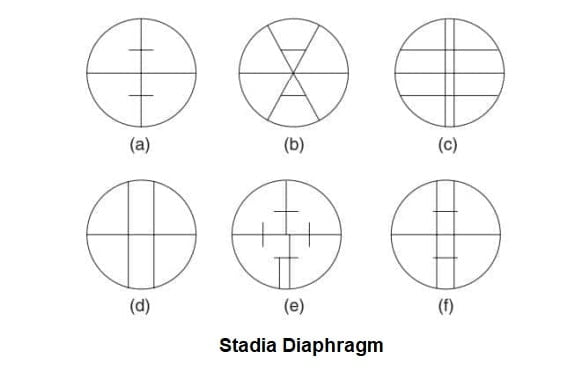
If LOS (line of sight) perpendicular to the staff
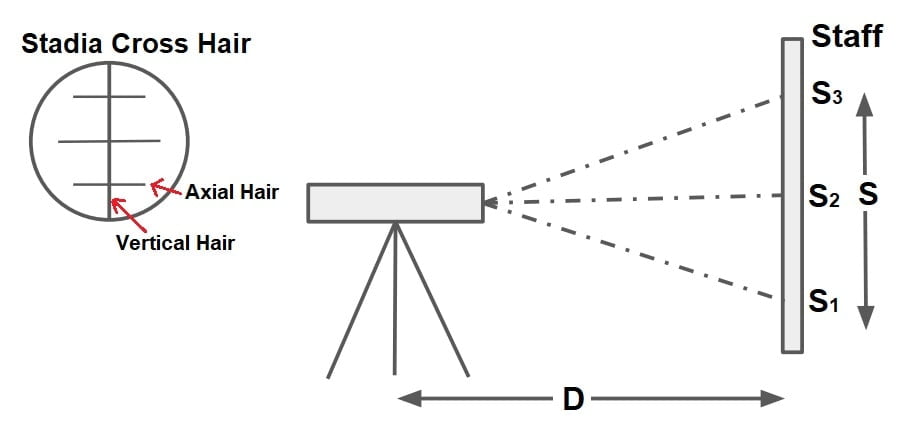
Tacheometry Equation
D= K·s + C
s= staff instercept (S3-S1)
D= Distance from intercept to staff
K= Multiplying constant
C= Additive Constant
Anallactic Lens : The telescope is fitted with an anallactic lens which makes the additive constant zero.
For Anallactic lens
Multiplying constant K = 100
Additive Constant C = 0
Stadia Rod
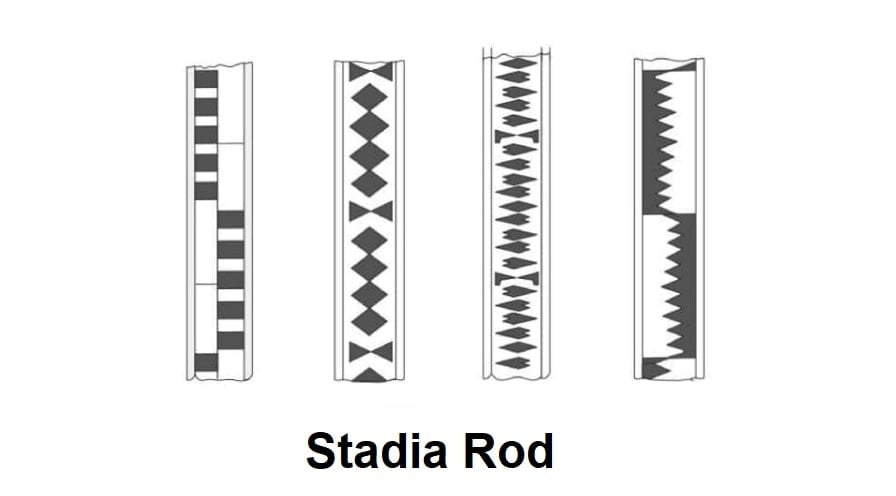
It is also known as the vertical stave. It is a rod 5- 15 m long, graduated in decimals of a metre. For small distances, say up to 100 m, an ordinary levelling staff may be used but beyond this a stadia rod is used, since the graduations of an ordinary levelling staff become indistinct. The staff can be held either vertical or normal to the line of sight.
Different Systems of Tacheometric Measurement
The various systems of tacheometric survey may be classified as follows:
- Stadia system
- Fixed Hair method or Stadia method
- Movable Hair method, or Subtense method.
- Tangential system.
- Subtense bar system
The principal common to all the systems to calculate the horizontal distance between two points and their difference in elevation.
Stadia System
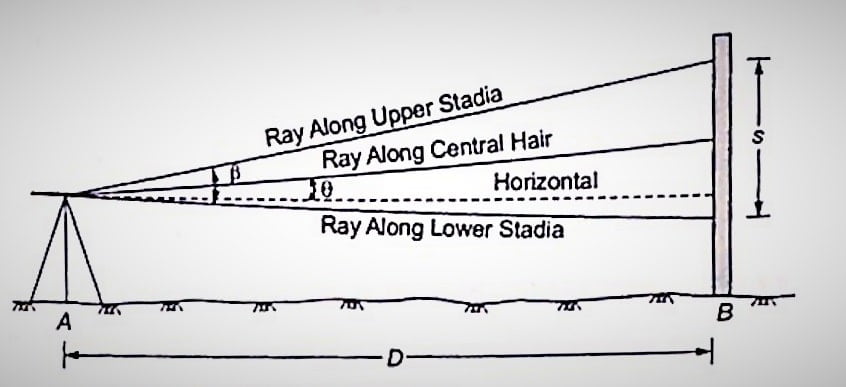
The stadia system of tacheometry is further classified as:
1.Fixed hair system
- In this system, the vertical distance between the upper and lower stadia hair is fixed and this fixed distance is called the stadia interval (i).
- Stadia interval is not changed during the measurement. When the tacheometer is targeted at staff then staff intercept (s) is obtained from the difference of readings of upper hair and lower hair.
- i= constant, s= variables.
2.Movable hair system
- In this method of tacheometry, the distance between the upper hair and lower hair (i.e, the stadia interval,) is varied by moving the stadia hairs vertically by the micrometer screws.
- Here the staff intercept (s) is fixed.
- The accuracy of the movable hair system is less compared to fixed hair system
- It is quite difficult to measure the stadia interval accurately, and thus the movable hair method is sparsely used. Fixed hair system is most commonly used in practice.
- i=variables , s= constant.
Tangential System
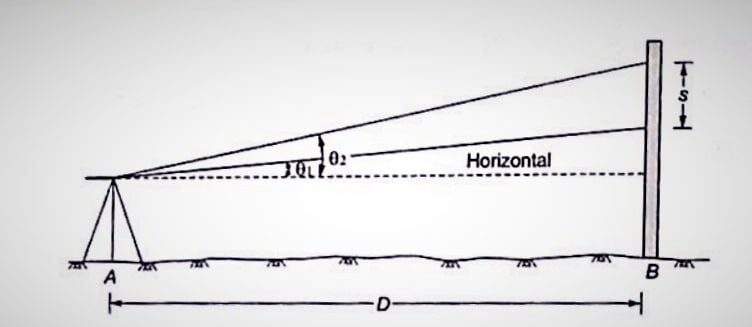
- Here in this system of tacheometry, the hairs are not at all required.
- This method can even be used when a telescope is not provided with a diaphragm.
- The staff has two targets at a fixed distance (s) apart.
- The vertical angles 0, and 0, are measured to the two targets.
- Now these vertical angles and the fixed distance on staff are used to determine the horizontal distance and difference of elevations.
Subtense Bar System
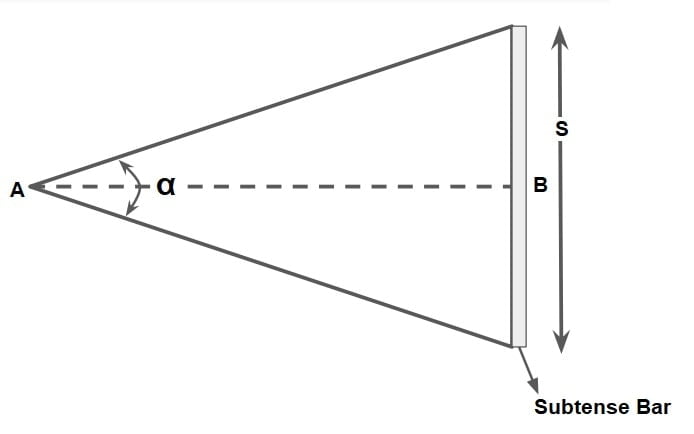
- Here in this system of tacheometry, a bar of fixed length is used which is known as a subtense bar.
- The sublense bar has two targets at the ends at a fixed distance (s) apart.
- The horizontal angle subtended between the instrument station A and the two targets on the subtense bar is measured.
Theory of Tacheometer
Let us assume that line of sight is horizontal and the telescope used is external focusing type.
 where
where
O = optical centre pf the object glass,
A’, B’ = the stadia wires,
A’ B’ = i = stadia interval,
C’ =horizontal cross-wire position,
AB = s = staff intercept,
f = focal length of object glass,
u = distance between the optical centre O and staff,
v = distance between the optical centre O and image of staff,
d = distance between the vertical axis of the tacheometer and the optical centre O
D = distance between the vertical axis of the tacheometer and the staff.
From the similar triangle AOB and A’OB’
\(\frac{AB}{A’B’}=\frac{OC}{OC’}=\frac{u}{v}\).
\(\frac{s}{i}=\frac{u}{v}\)….(1)
By the lens Formula
\(\frac{1}{u}+\frac{1}{v}=\frac{1}{f}\).
\(\frac{1}{u}\left \{ 1+\frac{u}{v} \right \}=\frac{1}{f}\).
from equation (1) \(\frac{s}{i}=\frac{u}{v}\)
\(\frac{1}{u}\left \{ 1+\frac{s}{i} \right \}=\frac{1}{f}\).
\(u=f+(\frac{f}{i})s\).
Distance from instrument to staff along LOS
D = u + d
we calculate \(u=f+(\frac{f}{i})s\)
\(D=f+(\frac{f}{i})s +d\)\(D=(\frac{f}{i})s + (f+d)\).
D= K·s + C
K= Multiplying constant = \(\frac{f}{i}\)
C= Additive Constan =(f+d)
Distance and Elevation Through Tacheometer
1.When a Staff Is Vertical
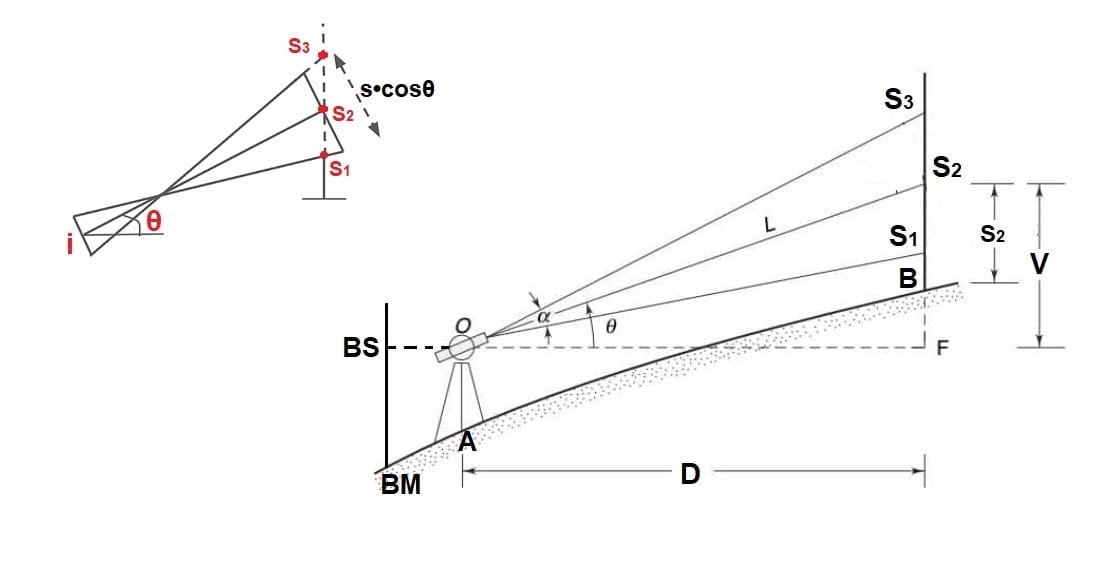
staff intercept = s = S3-S1
staff intercept perpendicular to line of sight = s•cosθ
Tacheometry Equation
L= K·s•cosθ + C
Horizontal Distance D = L·cosθ
Elevation V = L·sinθ
RL of B = RL of BM + BS + V – S2
BS= Back sight
2.When a Staff Is Perpendicular to Line of Sight
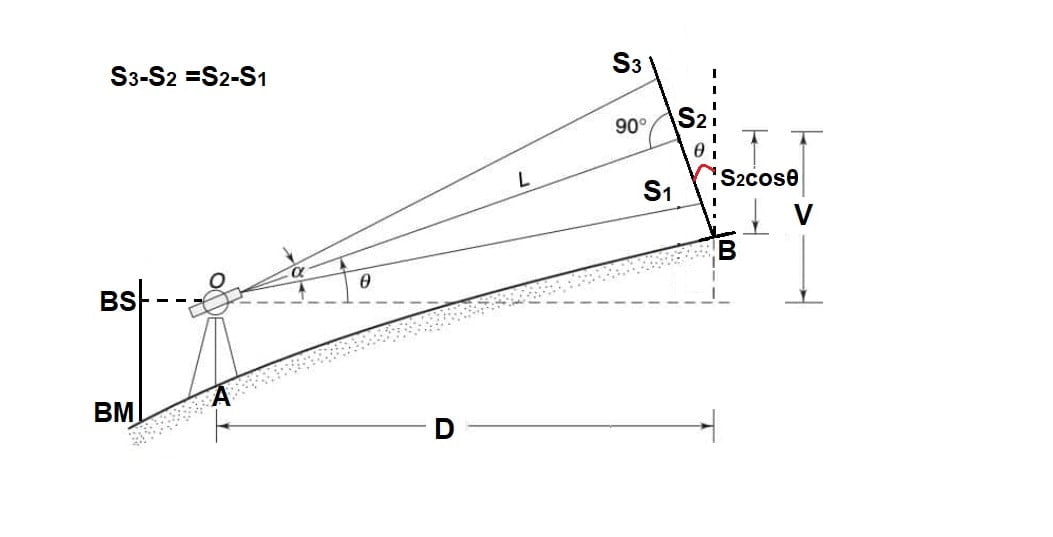
staff intercept = s = S3-S1
Tacheometry Equation
L= K·s+ C
Horizontal Distance D = L·cosθ +S2·sinθ
Elevation V = L·sinθ
RL of B = RL of BM + BS + V – S2·cosθ
BS= Back sight